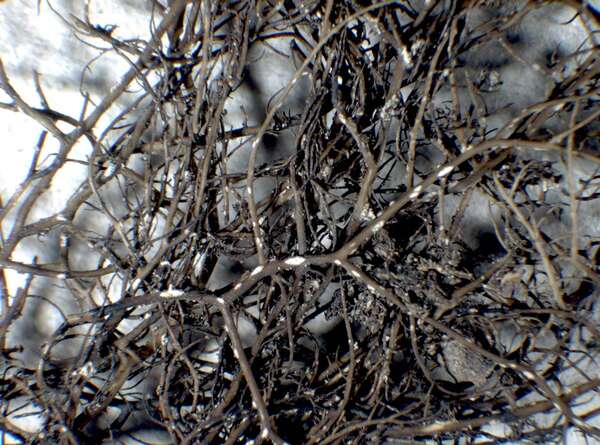Bryoria furcellata (Fr.) Brodo & D. Hawksw.
Opera Bot., 42: 103, 1977. Basionym: Cetraria furcellata Fr. - Syst. Orb. Veget., 1: 283, 1825.
Synonyms: Alectoria nidulifera Norrl.
Distribution: N - Frl, Ven, TAA (Ravera & al. 2020).
Description: Thallus fruticose, filamentous, forming tufts, attached by a basal holdfast, to 8(-10) cm long, pale to dark brown, shiny, usually without a main branch, isotomic-dichotomously branching, the branches terete, 0.3-0.5 mm thick, often with lateral spinules. Soralia common, fissural, oval to fusiform, even with thallus or mostly somewhat raised, narrower than the branches on which they arise, white, with numerous isidioid spinules. Pseudocyphellae absent; medulla white, compact. Apothecia extremely rare (never observed in Italian material), zeorine, with a pale brown disc, to 2 mm across. Asci 8-spored, Lecanora-type. Ascospores 1-celled, hyaline, subglobose to broadly ellipsoid, 6-7 x 3-4 μm. Photobiont chlorococcoid. Spot tests: cortex, medulla and soralia K- or K+ yellowish slowly turning brown, C-, KC-, P+ red. Chemistry: fumarprotocetraric acid.Note: a mainly boreal-montane, circumpolar lichen found on isolated conifers near treeline, sometimes on lignum.
Growth form: Fruticose filamentous
Substrata: bark and lignum
Photobiont: green algae other than Trentepohlia
Reproductive strategy: mainly asexual, by soredia, or soredia-like structures (e.g. blastidia)
Commonnes-rarity: (info)
Alpine belt: absent
Subalpine belt: rare
Oromediterranean belt: absent
Montane belt: absent
Submediterranean belt: absent
Padanian area: absent
Humid submediterranean belt: absent
Humid mediterranean belt: absent
Dry mediterranean belt: absent

Predictive model
Growth form: Fruticose filamentous
Substrata: bark and lignum
Photobiont: green algae other than Trentepohlia
Reproductive strategy: mainly asexual, by soredia, or soredia-like structures (e.g. blastidia)
Commonnes-rarity: (info)
Alpine belt: absent
Subalpine belt: rare
Oromediterranean belt: absent
Montane belt: absent
Submediterranean belt: absent
Padanian area: absent
Humid submediterranean belt: absent
Humid mediterranean belt: absent
Dry mediterranean belt: absent

Predictive model
 INDEX FUNGORUM
INDEX FUNGORUM
 GBIF
GBIF
 DOLICHENS
DOLICHENS




